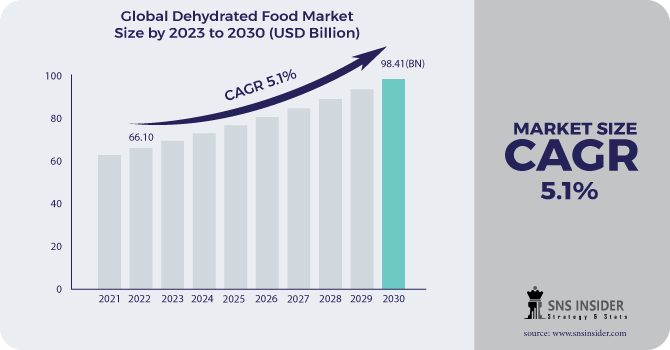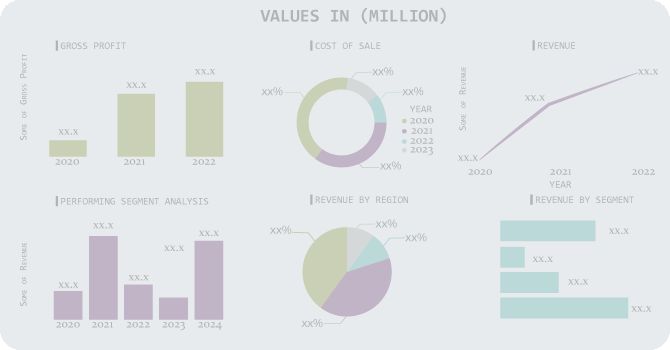Dehydrated Food Market Report Scope & Overview:
Dehydrated Food Market Size was valued at USD 66.10 billion in 2022 and is expected to reach USD 98.41 billion by 2030, and grow at a CAGR of 5.1% over the forecast period 2023-2030.
Drying or lack of hydration is a cycle through which dampness or water content is taken out from the food. Eliminating water content from food makes them lighter and more modest. It helps in the conservation of nourishment for a longer timeframe. Dehydrated food requires no refrigeration while protecting at home or during the hour of utilization.

In addition, dehydrated food is great for protecting occasional products of the soil. Dehydrated food offers high dietary benefits, simple capacity properties, and accessibility at a low value, which is driving the interest in dry-out food across the globe.
Got dehydrated food varieties are the food items from which dampness or water content has been taken out. In the parchedness interaction, the food item is dried to eliminate water, along these lines, broadening its timeframe of realistic usability. This makes the food item lighter and more modest while safeguarding its dietary benefit. Subsequently, dehydrated food sources can be safeguarded for a more drawn-out timeframe, without requiring any refrigeration. They can be effectively put away and are accessible at a low cost. Further, the lengthy timeframe of realistic usability of dehydrated food varieties makes it ideal for protecting occasional products of the soil.
Market Dynamics:
Driving Factors:
-
The storing idea of the shopper during the pandemic was brought about by a lengthy lockdown.
-
The rising buyer interest for bundled and handled food items.
Restraining Factors:
-
Restricted utilization of food items.
-
Variance underway volume and costs of vegetables and organic products because of climatic and political variables.
Opportunities:
-
The excess interest for good food items among the shoppers.
Challenges:
-
Agro-climatic conditions.
Impact of Covid-19:
The creation, which incorporates the drying cycles of getting dehydrated the food items have been stopped because of the ramifications of COVID-19. The modern tasks couldn't be executed and this prompted a decrease in how much stock was created.
The interruption in the store network for unrefined components frustrated the handling of drying out food items and the absence of transportation across borders stopped the commodity of got dehydrated food items. This prompted a deficient stockpile in contrast with the request and antagonistically influenced the income for the firm.
Market Estimations:
The dehydrated food market can likewise be fragmented based on types. This incorporates dehydrated dairy items, dehydrated organic products, dehydrated meat items, dehydrated vegetables, and others. Among this multitude of fragments, meat items are supposed to represent the biggest piece of the pie followed by dairy items.
Expanding interest for upgraded years around the accessibility of handled and canned meat items among the makers is supposed to help the interest of getting dehydrated meat items sooner rather than later. In addition, the dehydrated foods grown from the ground vegetable sections separately are normal and show a positive development during the gauge time frame. This is ascribed to the rising interest in occasional leafy foods.
Key Market Segments:
By Type:
-
Spray-dried
-
Freeze-dried
-
Vacuum-dried
-
Drum-dried
-
Others
By Product Type:
-
Dried Processed Food
-
Dried Fruit & Vegetable
-
Dried Dairy
-
Dried Meat & Seafood
-
Others
By Distribution Channel:
-
Hypermarket/Supermarket
-
Convenience Stores
-
Online Retailing
-
Others
By Application:
-
Household Consumption
-
Canned Food Products
-
Others
.png)
Regional Analysis:
-
North America
-
USA
-
Canada
-
Mexico
-
-
Europe
-
Germany
-
UK
-
France
-
Italy
-
Spain
-
The Netherlands
-
Rest of Europe
-
-
Asia-Pacific
-
Japan
-
south Korea
-
China
-
India
-
Australia
-
Rest of Asia-Pacific
-
-
The Middle East & Africa
-
Israel
-
UAE
-
South Africa
-
Rest of Middle East & Africa
-
-
Latin America
-
Brazil
-
Argentina
-
Rest of Latin America
-
Dehydrated food markets can likewise be portioned based on district. Universally, North America is supposed to represent a significant piece of the pie. In the North American locale, the U.S is supposed to be the significant benefactor as far as income followed by Canada.
Expanded utilization of meat items in North America is supposed to help the interest in dehydrated food items across the area. Europe is additionally expected to be one of the noticeable donors in got dehydrated food items market as far as income followed by the Asia Pacific. Among every one of the nations in the European area United Kingdom is supposed to contribute the most elevated during the conjecture time frame.
Additionally, as far as the creation of dehydrated food China is supposed to be one of the conspicuous makers of dehydrated food items. Furthermore, China is one of the biggest meat items makers alongside prime maker of different occasional products of the soil. This is supposed to contribute toward critical development in the country.
Key Players:
Major key players included in this report are, Unilever plc., Chaucer Foods Ltd, Nissin Food Holdings Co. Ltd., Harmony House Foods, Inc., Mercer Foods, LLC., Others.
Chaucer Foods Ltd-Company Financial Analysis

| Report Attributes | Details |
|---|---|
| Market Size in 2022 | USD 66.10 Billion |
| Market Size by 2030 | USD 98.41 Billion |
| CAGR | CAGR 5.1% From 2023 to 2030 |
| Base Year | 2022 |
| Forecast Period | 2023-2030 |
| Historical Data | 2020-2021 |
| Report Scope & Coverage | Market Size, Segments Analysis, Competitive Landscape, Regional Analysis, DROC & SWOT Analysis, Forecast Outlook |
| Key Segments | • by Type (Spray-dried, Freeze-dried, Vacuum-dried, and Others) • by Product (Dried Processed Food, Dried Fruit & Vegetable, Dried Dairy, and Others) • by Distribution Channel (Hypermarket/Supermarket, Convenience Stores, Online Retailing and Others) |
| Regional Analysis/Coverage | North America (USA, Canada, Mexico), Europe (Germany, UK, France, Italy, Spain, Netherlands, Rest of Europe), Asia-Pacific (Japan, South Korea, China, India, Australia, Rest of Asia-Pacific), The Middle East & Africa (Israel, +D11UAE, South Africa, Rest of Middle East & Africa), Latin America (Brazil, Argentina, Rest of Latin America) |
| Company Profiles | Unilever plc., Chaucer Foods Ltd, Nissin Food Holdings Co. Ltd., Harmony House Foods, Inc., Mercer Foods, LLC., Others. |
| Key Drivers | •The storing idea of the shopper during the pandemic was brought about by a lengthy lockdown. •The rising buyer interest for bundled and handled food items. |
| Market Opportunities | •The excess interest for good food items among the shoppers. |

